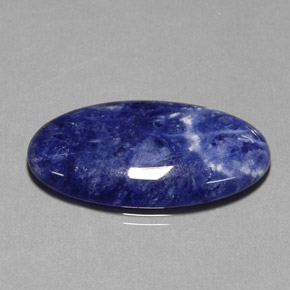The Gemstone Sodalite

Sodalite is a blue gemstone almost invariably veined with white streaks or markings. Its ideal color is an intense blue, and it comes in all shades of blue from light blue to deep royal-blue, and from grayish-blue to violet. Different shades of blue will often be present in a single gemstone. Sodalite is an opaque gemstone, though it is slightly translucent on thin edges.
Chemical Formula
?
Na
8Al
6Si
6O
24Cl
2
Additional Properties
|
Refractive Index
?
1.48 |
Double Refraction
?
None |
Transparency
?
Opaque |
SG
?
2.2 - 2.3 |
Luster
?
Greasy or waxy |
| Cleavage ?
3,6 |
All About
Sodalite is not a prevalent gemstone, and suitable material only comes from a handful of localities. Despite this, Sodalite is a fairly inexpensive and obtainable. It is very similar to the more popular
Lapis Lazuli, and may be used as a substitute for that more valuable gemstone.
Sodalite can be strongly
fluorescent, often fluorescing bright orange to red, or cream. It may also be
tenebrescent, in that its color will deepen upon exposure to
ultraviolet light. This is especially true of the purple variety
Hackmanite.
Uses
?
Sodalite is a minor gemstone and usually faceted into beads for necklaces and bracelets, with individual beads usually large in size.
Tumbled rough Sodalite is also strung and used in jewelry. Sodalite is also used for ornamental carvings such as animal carvings and small statues.
Varieties
?
-
Hackmanite
-
Purple, sulfur-rich variety of Sodalite, usually with a pink or purple color. Hackmanite is an uncommon gemstone and is known for its tenberescent ability.
Treatments & Enhancements
?
Sodalite is natural and not treated or enhanced.
Sodalite Sources
?
The primary workable Sodalite deposits are in Afghanistan, Australia, Brazil, and Canada (Ontario and British Columbia).
Similar Gemstones
?
Lapis Lazuli can appear similar to Sodalite with its intensely blue color, though it is usually associated with sparkling
Pyrite which Sodalite lacks.
Sodalite in the Rough Photos
?